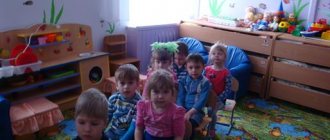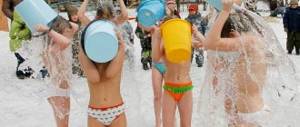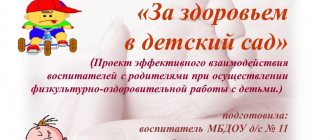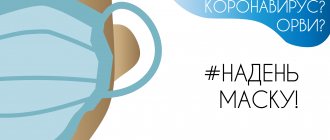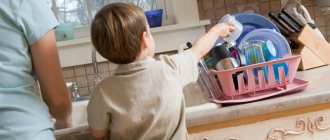Nutrition culture in preschool educational institutions
"Dining etiquette for preschoolers"
“Cultural education begins very early, when the child is very
far from being literate when he just learned to see well,
hear and say something."
A. S. Makarenko
Etiquette lessons begin at an early age. The child learns not only to behave correctly at the table, but also to confidently use cutlery, be neat and polite, and gains an understanding of food culture and its importance for human health.
Teachers today are faced with the question of how to teach children the culture of nutrition, the rules of behavior at the table generally accepted in the international community, and even create conditions that contribute to improving the culture of behavior in the family.
Table setting rules
Each child has a permanent place at the table.
Children learn to use cutlery: from 1.5-2 years old they eat with a spoon on their own, from 3 years old they use a fork. From the middle group, children are given a full set (spoon, fork, knife)
.
A beautiful table setting not only stimulates the appetite, but also creates a friendly mood in children towards each other. It also instills a love of beauty, respect for food, and the inadmissibility of a careless attitude towards it. So for each season you can make special napkin holders and select tablecloths.
The teacher tries to focus each child's attention on food. It is necessary to monitor the behavior of children at the table, maintain cleanliness and tidiness, teach them to chew food well, not swallow it in large pieces, eat everything that is offered, not break the bread, but bite it off.
During feeding, children are told about the pleasant appearance, taste, smell of food, and its usefulness. There is no need to force a child if he does not want to eat all the food. Feeding a child against his or her wishes can cause food aversions. Don’t forget to wish your children “Bon Appetit” - this is a must!
After finishing the meal, the children carefully blot their mouths with a napkin and wipe their hands, thank them for the food and leave the table. Children should not be allowed to leave the table with a piece of bread or other food.
Educators pay great attention to children with decreased appetite. When feeding such children, it is especially important to follow the recommended age-specific portion sizes and take into account individual tastes and habits. In each group there are children who like to eat only broth, or do not eat boiled cabbage at all, and there are children who are scared by a large portion of soup. The wishes of the children must be taken into account.
Children with poor appetite can be offered a small amount of water or compote during meals so that they can wash down dense food.
Dishes such as meat and fish cutlets, cottage cheese and other casseroles are given to children uncut (this stimulates the appetite and affects the secretion of gastric juice), we teach them to separate one piece at a time with the edge of a fork and eat it by picking it up on the fork, rather than cutting it right away the entire portion received.
Dishes play an equally important role. Colorful mugs and plates increase appetite to a greater extent than plain and featureless dishes. It must be remembered that it must meet all hygienic requirements, which is why aluminum is not used in baby food. Plastic utensils are also not acceptable, except as additional accessories, such as napkin holders or bread bins.
The strongest incentive in the formation of a nutrition culture is encouragement:
— "The Queen of the Table and the King"
. The crown is given to the child who has eaten the best.
— "Table of Honor"
A flag and a vase of flowers are placed on this table.
Medal "For the Cleanest Plate"
.
Thematic selection of games and exercises, topic: “Food”
Goals:
Expand children's knowledge about food. Enrich children's active and passive vocabulary on this topic. Learn to listen carefully and understand poetic text. Form ideas about color, position in space (on, behind, in front, next to, top-bottom, right-left), geometric shapes (rectangle, square, triangle, circle, oval), size (big-small). Teach children to find exactly the same object, as well as an object that is different from the rest. Improve the skills of gluing, sculpting, and drawing straight vertical lines with a pencil. Teach children to find the middle of an object. Teach children to cut paper with scissors. Develop thinking, fine motor skills, coordination of movements. Practice the ability to coordinate your actions with the words of the song. Foster a desire to be careful when eating and use a napkin.
Equipment:
Packaging for various food products (two copies each). Pictures “Find the extra item” (food). Cardboard plates, PVA glue, buckwheat. Salt dough, toy knives, candy wrappers. Pictures depicting ears of grain, grains, flour, dough, bakery products. Leaf background with a picture of a road. Small cars. Sheet-background with images of plates of different shapes; cut out color images of bread, cookies, pie, loaf, bagel; glue. Large white and small brown beans. Large and small plates. Scissors. Paper-cut images of bread and sausage. Clothespins. Multi-colored silhouette images of lollipops. Handouts “tomatoes”, “cucumbers”, “pears”, “plums”; circles-plates of red, blue, yellow and green colors. Clothesline. Silhouette images of mushrooms. Drying. Strings. A picture of a neat and messy child eating. Paper napkins. Round cardboard “pizzas” with Velcro, small pieces of sausage, tomatoes, mushrooms, cheese on Velcro. Pictures-backgrounds depicting candies in the form of geometric shapes with an empty middle, corresponding geometric shapes. Pencils. Sheets with food items drawn at the top and plates at the bottom, which need to be connected by a vertical line. Audio recordings: “Dance with Mom”, “I bake, bake, bake a pie for all the kids.”
Progress of the lesson:
When they say “Bon appetit?” This is what they say before eating. Today we will play and talk about what we eat.
When you are offered a treat - Fruit cake, sweets and cookies - Eat calmly, carefully. Everyone around will be pleased.
What should you say before eating? What should you say after eating?
Didactic game “Buy the exact same product in the store”
Children are given empty packaging of various food products. Children must go to the “store” (where the same packages are placed) and choose to “buy” exactly the same product.
Didactic exercise “What is inedible?”
Look at the picture carefully and show what is inedible and what cannot be eaten.
Children use pencils to draw vertical straight lines from the product to the plate.
Exercise "Pizza"
Prepare a real pizza - put slices of sausage, cheese, mushrooms, tomatoes on top.
Looking at pictures
You love to eat cookies, buns, bread. Look and listen to how and what they came from. (The display of pictures is accompanied by a story from an adult).
Picture "Ears". Picture "Grain". Picture "Flour". Picture "Dough". Picture “Bakery products”.
Didactic game “Grain Truck”
Place sheets of paper with a city drawn in front of you and pick up a grain truck. You will be the drivers and drive the car in the right direction.
Place the car in the upper left corner. There is a bakery here and fresh bread, rolls and other delicious products will be loaded into the car. Drive the car to the center, to the very middle. Now the car has moved to the right. Now down the street. The car stopped in front of a tall building. Then the car went to the left. She stopped behind a low house. The car drove up the street. The car returned to the bakery.
Application “Choose the dish of the desired shape”
We bought various products at a bakery store. Now you need to lay them out on the festive table. You don't have a tablecloth with dishes placed on it. Consider carefully bakery products and dishes for them. You need to choose a dish of suitable shape for each product. What geometric shape does a donut resemble? To the circle. What shape of dish should I place a round bagel on? On a round dish. What geometric shape does bread resemble? To a rectangle. What shape of dish should I place rectangular bread on? On a rectangular dish. What geometric figure does the loaf resemble? To the oval. What shape of dish should I place the oval loaf on? On an oval dish. What geometric shape does the pie resemble? To the triangle. What shape of dish should I place the triangular pie on? On a triangular dish. What geometric shape does the cookie resemble? Per square. What shape of dish should I place square cookies on? On a square dish.
Reading the poem "Bread"
Flour was kneaded into the dough. And from the dough we made: Pies and buns, Butter cheesecakes, Buns and rolls - We will bake everything in the oven. Delicious!
Modeling “Kolobok, loaf, bagel”
Take pieces of salt dough in your hands and roll a bun (circular rolling), a loaf (straight rolling, pressing, cutting), a bagel (straight rolling, folding, joining).
Dynamic pause “I bake, I bake, I bake”
Children perform movements as shown by an adult to the song “I bake, bake, bake.”
Didactic game “Put the food on plates”
Here are vegetables and fruits in front of you. Name them: cucumbers, tomatoes, plums, pears. Tell me what color they are? Green cucumbers, red tomatoes, yellow pears, blue plums. Place them on plates of a suitable color.
Didactic exercise “Sorting beans”
There are beans mixed on a plate. There are white beans, large ones, and there are brown beans, small ones. Place the large beans on large plates and the small beans on a small plate.
Didactic game “Arrange the candies”
Select candies of suitable shape and arrange them in the picture.
Game with clothespins “Candy on sticks”
Here are the sweets in front of you. Show the candy in red, yellow, blue, green. Now match each candy with a stick of the same color.
Handmade “Candy”
Pinch off large pieces from the salt dough, roll into a thick sausage and wrap in candy wrappers.
Reading the poem “Delicious porridge” by Z. Alexandrova
Buckwheat porridge, Where was it cooked? In the oven. Mated, reproached. So that Olenka eats it. They cooked the porridge, divided it among everyone... The geese on the path, the chickens in the basket, the tits in the window got a spoonful. A spoonful was enough for the dog and the cat. And Olya finished the last crumbs!
Manual labor “Porridge on a plate”
Spread glue (amply) in the middle of the plate and sprinkle cereal on top. Shake off or blow away any remaining cereal.
Didactic exercise “Divide in half”
Take scissors and cut the sausage and bread in half.
Show me a mushroom that is not like all the other mushrooms.
Didactic exercise “Drying mushrooms”
Squirrels dry mushrooms on tree branches. And people hang mushrooms to dry on a string. Now we will hang the mushrooms to dry on a string using clothespins.
Dance exercise “Dance with Mom”
Children perform movements to the music according to the text.
Didactic exercise “Good and bad”
Children look at the picture and explain which child behaves well at the table and which one behaves poorly.
How do you behave at the table? Try to eat carefully. So as not to get dirty. Use a napkin. To wipe your mouth after eating. Show how you wipe your mouth with a napkin.
Nutrition culture in kindergarten
Nadezhda Nikolaeva
Nutrition culture in kindergarten
Nutrition culture in kindergarten is a science necessary in modern life. Fast food, which looks attractive in conditions of eternal lack of time, strives to displace healthy food from our diet. This is not at all beneficial for a growing child's body . Since children spend most of the day in kindergarten , it is the educators who have the responsibility to teach the child how to eat healthy, tasty, beautifully and, most importantly, carefully .
Etiquette lessons begin at an early age. The child learns not only to behave properly at the table, but also to confidently use cutlery, be neat and polite.
Table setting rules
In kindergarten, children are taught to eat in the classic , European manner - fork in the left hand, knife in the right. Based on this, tables are set. Forks are given to children starting from the younger group, and knives - from the older group.
It is advisable for each group to have its own dishes, the colors of which may correspond to the name of the group ( “Daisies”
,
"Kids"
). When moving to an older group, the set of dishes changes.
In the older group, an additional item may appear on the tables - a salt shaker with a small spoon. Often children, not wanting to eat a low-salt dish, refuse to eat. But it is enough to allow them to add a little salt to the dish, and the appetite immediately appears. Of course, children need to be told that excess salt is extremely harmful and that moderation must be observed.
Depending on the meal time, tables are set differently.
For breakfast, a vase of flowers, a bread box, a plate with portioned butter, a napkin holder, and saucers are placed in the middle of the table. Forks are laid out on the left side, knives on the right, spoons parallel to the edge of the table. To keep it warm, the main course is served only when the child sits down at the table. Dishes are removed to the left of the sitting child.
For lunch, the table is set in a similar way, but juice and compote are poured into cups on the table in advance, and plates are placed in a pile on the edge of the table. At the same time, in the younger groups only deep plates are placed, and in the middle and older groups - deep and small plates in cases where the second dish is laid out in the group and not brought from the kitchen. Used dishes are immediately removed.
Some kindergartens encourage children's habits that may not always be considered healthy. For example, many children who do not like boiled onions, carrots or cabbage put them on a plate prepared in advance by the nanny. However, educators must work with students , trying to teach them to eat all the thick liquid along with the liquid. As a last resort, you can put a piece of onion on the edge of your plate.
For afternoon tea, the table is set as for breakfast - with the only difference: butter is not served.
Formation of cultural and hygienic skills at the table
As a child grows, his table manners improve. Go to the nursery and senior groups, and you will not only see, but also hear the difference. The kids sit as if due to their age and restlessness, the crumbs are scattered, trying to chat - not everywhere, of course, but this is a typical picture. And take the older group: the children sit and eat quietly, no one chats, no one laughs. After eating, they wipe themselves with a napkin, thank the nanny and help the attendant clean up the dishes.
Young children (1-2 years)
learn:
wash your hands before eating and dry them with a towel (with the help of an adult)
;
sit down at a chair;
use a cup: hold it in such a way that the liquid does not spill, drink slowly;
use a spoon;
wipe yourself with a napkin after eating;
eat thick food with a spoon or with bread;
After finishing the meal, leave the table and push in your chair.
Children of the first junior group (2-3 years old)
learn:
Wash your hands yourself before eating, wipe them dry with a towel;
eat neatly, holding a spoon in your right hand;
wipe yourself with a napkin after eating;
give thanks after eating.
Children of the second younger group (3-4 years old)
learn:
wash your hands independently and carefully with soap, dry yourself with a towel, hang the towel in its place;
use cutlery correctly;
eat carefully: do not crumble the bread, chew food with your mouth closed.
Children of middle and older groups (4-5 years old, 5-6 years old)
learn:
take food in small portions;
eat quietly;
use cutlery correctly (fork, spoon, knife)
;
sit with a straight back;
neatly arrange dishes after meals;
take some of the dishes with you.
Children of the preparatory group for school (6-7 years old)
consolidate the acquired skills
of table manners : do not put your elbows, sit up straight, chew food thoroughly, use cutlery correctly.
Forms of instilling a food culture
The forms of instilling a culture of nutrition in kindergarten are varied . One of them is duty. Desk attendants are given an elegant uniform consisting of colored caps and aprons. All these clothes are stored in the "Duty Corner"
.
Children begin to be on duty from the second junior group, at the end of the school year. The attendant helps the nanny set the table, at which he eats. The preschooler arranges glasses, puts napkins, spoons, and puts out bread bins.
In the middle group, children consolidate table setting skills. In the second half of the year, responsibilities increase: arrange the saucers that the nanny had previously placed on the table, put napkins in glasses, remove bread bins and glasses with napkins after meals.
